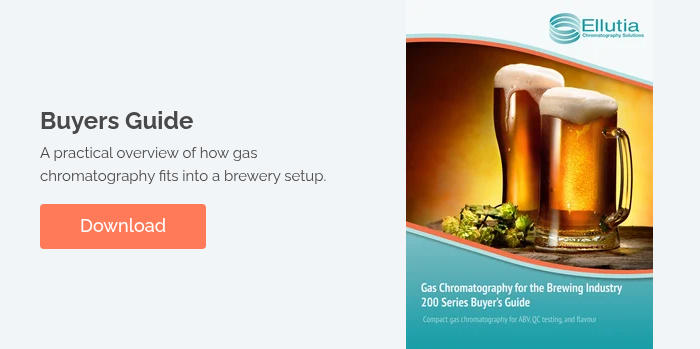Measuring ABV in Alcohol-free Cider
Application Note:
ABV testing in alcohol-free cider using gas chromatography.
Introduction
Producing alcohol-free cider that meets label claims requires careful control. At trace levels of ethanol, even small measurement errors can push a product above the 0.05% threshold.
Hydrometers and oscillating density meters estimate alcohol from density, but in cider, that approach quickly breaks down. Sugars, organic acids, pectins, CO₂, and flavour additives all affect density, so a “0.0%” reading often isn’t what it seems.
Gas chromatography gives a direct measurement of ethanol. It provides accurate %ABV results at very low concentrations, helping cider producers confirm alcohol-free claims with confidence.

The Challenge
Why traditional testing struggles with alcohol-free cider
Alcohol-free cider presents two main challenges. First, the amount of ethanol is so small that its effect on density is within the uncertainty caused by other compounds. Second, the cider matrix itself is complex. Sugars, acids, polyphenols, pectins, and stabilisers all shift density and viscosity, while dissolved CO₂ adds further variability.
Even when density meters are calibrated correctly, those factors can cause bias at near-zero levels. Arrested fermentation, dealcoholisation, and back-sweetening make things even harder to measure consistently. External lab testing provides accuracy but is too slow for same-day blending or release decisions.
Producers need a quick, direct, and defensible way to measure ethanol on-site, without relying on density corrections or lab queues.

The Solution
Measuring ethanol directly in alcohol-free cider
Gas chromatography removes the uncertainty of indirect testing. It separates every compound in the sample and measures ethanol on its own. The result is a true %ABV value that remains accurate even when ethanol levels are only a few hundredths of a percent.

With the Ellutia 200 Series GC, cider producers can test samples in-house and get precise, repeatable results within minutes. This allows faster product release, consistent quality control, and traceable documentation for alcohol-free labelling.
Gas chromatography is especially well-suited to cider because it deals with high-sugar, high-solids samples easily. By analysing ethanol independently of other ingredients, it provides clear and reliable data every time.
If you’d like a practical overview of how gas chromatography fits into a brewery setup, take a look at the 200 GC Buyers Guide for Breweries.
Method Overview
How alcohol-free cider is tested using gas chromatography
Once the system is ready, the process is simple. A small cider sample is prepared, calibration standards are run to build a reference curve, and the instrument measures ethanol directly against that curve.
Before testing, the cider is degassed by gently pouring it between two beakers to release dissolved CO₂. This prevents bubbles from affecting the injection. If the sample looks cloudy, it can be filtered to remove particulates before analysis.
Calibration standards are prepared using ethanol in water, covering concentrations from 0.01% to 10%. These standards define the calibration curve used to calculate ethanol content.
The method uses the following GC conditions:
- Column: EL-5, 30 m × 0.25 mm × 0.25 µm
- Injector: 250 °C, split mode, 0.5 µL injection
- Detector: FID at 300 °C
- Oven program: Start 100 °C (hold 0.1 min), ramp 20 °C/min to 170 °C (hold 1 min)
Watch
How to Prepare Calibration Standards for Alcohol-Free Cider Testing
Learn how to create accurate ethanol calibration standards for measuring trace alcohol levels in alcohol-free cider. This step-by-step video explains how to prepare, dilute, and store standards that produce a precise calibration curve for GC analysis.
How to Measure Trace Alcohol in Alcohol-Free Cider Using Gas Chromatography
Follow the complete workflow for analysing alcohol-free cider using the Ellutia 200 Series GC. This guide covers every step, from sample preparation to chromatogram review, showing how to measure trace ethanol levels accurately and confirm alcohol-free compliance.
Results and Reliability
What the results show
The ethanol calibration from 0.01% to 10.00% v/v produced a smooth, linear response with an R² value of 0.9999882. This confirms stable detector performance and reliable quantification across the full range.
An alcohol-free cider sample tested using this method measured 0.033% v/v ethanol, comfortably below the 0.05% threshold for alcohol-free labelling. The chromatogram showed a clean ethanol peak with a flat baseline, confirming accurate measurement at trace levels.
Testing alcohol-free cider with gas chromatography gives producers accurate, traceable data on every batch. You can verify alcohol-free claims before packaging, check product consistency, and make confident release decisions without delay.
Learn More
Get the full method and results
If you’d like to see the full details behind this testing method, you can download the complete application note. It includes chromatograms, calibration data, and the exact conditions used for the analysis. It’s a handy reference if you want to check your own setup or compare results.
Download the full application note.
It only takes a few moments to signup.
Frequently Asked Questions
-
How is alcohol-free cider tested for ethanol content?Alcohol-free cider can be tested using gas chromatography. The method separates ethanol from other compounds and measures it directly, giving accurate results at trace levels.
-
Why can density-based methods give false readings?Cider contains sugars, acids, and stabilisers that affect density and viscosity. These factors can hide the small change caused by ethanol, making hydrometer or density-meter readings unreliable.
-
Can gas chromatography be used on-site in a brewery?
Yes. Compact systems such as the Ellutia 200 Series GC make it possible to measure ethanol accurately in your own brewery. This removes the need to send samples to external labs and allows faster decision-making before packaging.
-
How long does a gas chromatography test take?Each run typically takes just a few minutes. Once the instrument is calibrated, results can be reviewed almost immediately.
-
What else can the 200 Series GC be used for in brewing?Alongside alcohol-free testing, the same system can be used for flavour profiling and volatile compound analysis, helping brewers control both product quality and consistency.



